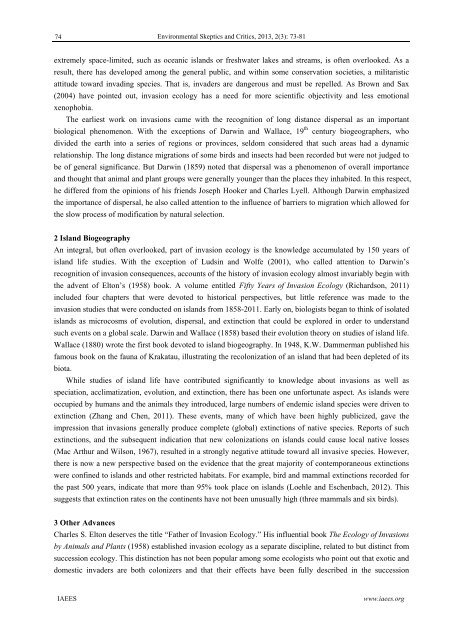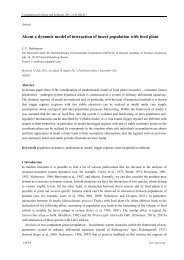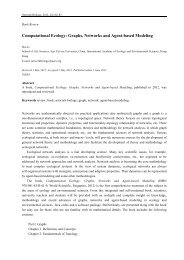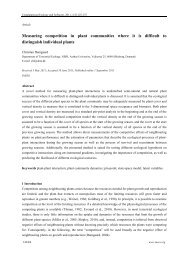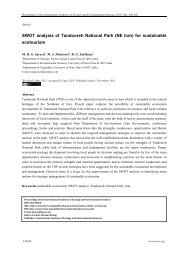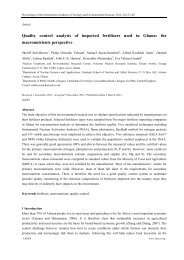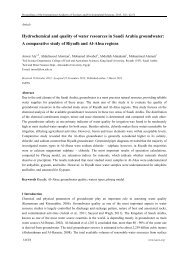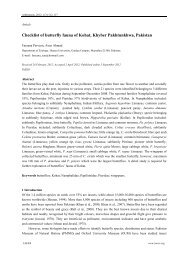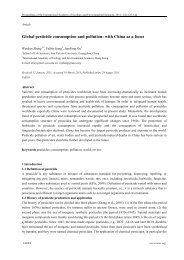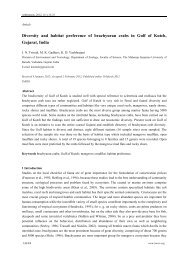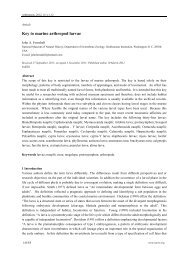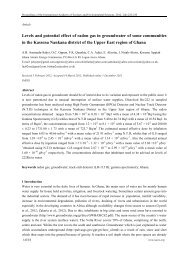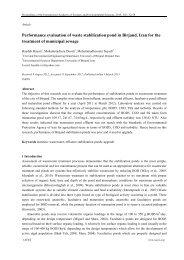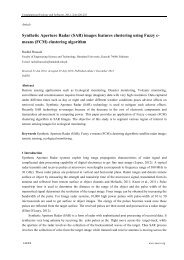Invasion ecology: Origin and biodiversity effects - JournalTOCs
Invasion ecology: Origin and biodiversity effects - JournalTOCs
Invasion ecology: Origin and biodiversity effects - JournalTOCs
Create successful ePaper yourself
Turn your PDF publications into a flip-book with our unique Google optimized e-Paper software.
74<br />
Environmental Skeptics <strong>and</strong> Critics, 2013, 2(3): 73-81<br />
extremely space-limited, such as oceanic isl<strong>and</strong>s or freshwater lakes <strong>and</strong> streams, is often overlooked. As a<br />
result, there has developed among the general public, <strong>and</strong> within some conservation societies, a militaristic<br />
attitude toward invading species. That is, invaders are dangerous <strong>and</strong> must be repelled. As Brown <strong>and</strong> Sax<br />
(2004) have pointed out, invasion <strong>ecology</strong> has a need for more scientific objectivity <strong>and</strong> less emotional<br />
xenophobia.<br />
The earliest work on invasions came with the recognition of long distance dispersal as an important<br />
biological phenomenon. With the exceptions of Darwin <strong>and</strong> Wallace, 19 th century biogeographers, who<br />
divided the earth into a series of regions or provinces, seldom considered that such areas had a dynamic<br />
relationship. The long distance migrations of some birds <strong>and</strong> insects had been recorded but were not judged to<br />
be of general significance. But Darwin (1859) noted that dispersal was a phenomenon of overall importance<br />
<strong>and</strong> thought that animal <strong>and</strong> plant groups were generally younger than the places they inhabited. In this respect,<br />
he differed from the opinions of his friends Joseph Hooker <strong>and</strong> Charles Lyell. Although Darwin emphasized<br />
the importance of dispersal, he also called attention to the influence of barriers to migration which allowed for<br />
the slow process of modification by natural selection.<br />
2 Isl<strong>and</strong> Biogeography<br />
An integral, but often overlooked, part of invasion <strong>ecology</strong> is the knowledge accumulated by 150 years of<br />
isl<strong>and</strong> life studies. With the exception of Ludsin <strong>and</strong> Wolfe (2001), who called attention to Darwin’s<br />
recognition of invasion consequences, accounts of the history of invasion <strong>ecology</strong> almost invariably begin with<br />
the advent of Elton’s (1958) book. A volume entitled Fifty Years of <strong>Invasion</strong> Ecology (Richardson, 2011)<br />
included four chapters that were devoted to historical perspectives, but little reference was made to the<br />
invasion studies that were conducted on isl<strong>and</strong>s from 1858-2011. Early on, biologists began to think of isolated<br />
isl<strong>and</strong>s as microcosms of evolution, dispersal, <strong>and</strong> extinction that could be explored in order to underst<strong>and</strong><br />
such events on a global scale. Darwin <strong>and</strong> Wallace (1858) based their evolution theory on studies of isl<strong>and</strong> life.<br />
Wallace (1880) wrote the first book devoted to isl<strong>and</strong> biogeography. In 1948, K.W. Dammerman published his<br />
famous book on the fauna of Krakatau, illustrating the recolonization of an isl<strong>and</strong> that had been depleted of its<br />
biota.<br />
While studies of isl<strong>and</strong> life have contributed significantly to knowledge about invasions as well as<br />
speciation, acclimatization, evolution, <strong>and</strong> extinction, there has been one unfortunate aspect. As isl<strong>and</strong>s were<br />
occupied by humans <strong>and</strong> the animals they introduced, large numbers of endemic isl<strong>and</strong> species were driven to<br />
extinction (Zhang <strong>and</strong> Chen, 2011). These events, many of which have been highly publicized, gave the<br />
impression that invasions generally produce complete (global) extinctions of native species. Reports of such<br />
extinctions, <strong>and</strong> the subsequent indication that new colonizations on isl<strong>and</strong>s could cause local native losses<br />
(Mac Arthur <strong>and</strong> Wilson, 1967), resulted in a strongly negative attitude toward all invasive species. However,<br />
there is now a new perspective based on the evidence that the great majority of contemporaneous extinctions<br />
were confined to isl<strong>and</strong>s <strong>and</strong> other restricted habitats. For example, bird <strong>and</strong> mammal extinctions recorded for<br />
the past 500 years, indicate that more than 95% took place on isl<strong>and</strong>s (Loehle <strong>and</strong> Eschenbach, 2012). This<br />
suggests that extinction rates on the continents have not been unusually high (three mammals <strong>and</strong> six birds).<br />
3 Other Advances<br />
Charles S. Elton deserves the title “Father of <strong>Invasion</strong> Ecology.” His influential book The Ecology of <strong>Invasion</strong>s<br />
by Animals <strong>and</strong> Plants (1958) established invasion <strong>ecology</strong> as a separate discipline, related to but distinct from<br />
succession <strong>ecology</strong>. This distinction has not been popular among some ecologists who point out that exotic <strong>and</strong><br />
domestic invaders are both colonizers <strong>and</strong> that their <strong>effects</strong> have been fully described in the succession<br />
IAEES<br />
www.iaees.org


